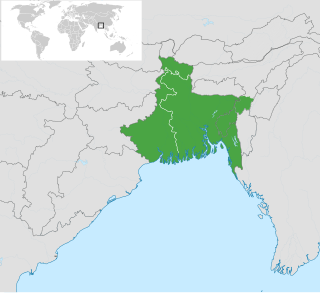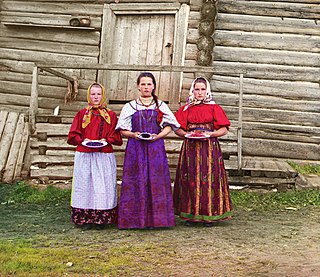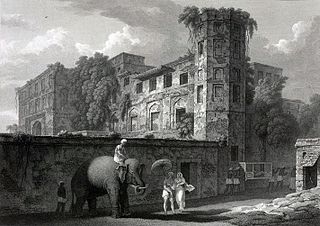
A zamindar, zomindar, zomidar, or jomidar, in the Indian subcontinent was an aristocrat. The term means land owner in Persian. Typically hereditary, zamindars held enormous tracts of land and control over their peasants, from whom they reserved the right to collect tax on behalf of imperial courts or for military purposes. Their families carried titular suffixes of lordship
. In the 19th and 20th centuries, with the advent of British imperialism, many wealthy and influential zamindars were bestowed with princely and royal titles such as Maharaja, Raja (King) and Nawab.
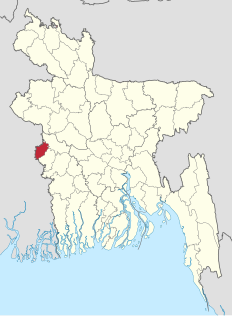
Meherpur is a district in South-western Bangladesh.
Sirajul Islam is the chairman of the Board of Editors of Banglapedia, the national encyclopedia of Bangladesh, and the editor of the Journal of the Asiatic Society of Bangladesh. He is a prominent Bangladeshi historian, famous for his works on agriculture, British era land tenure and social history of Bengal.

Barisal, officially known as Barishal, is a major city that lies on the bank of Kirtankhola river in south-central Bangladesh. It is the largest city and the administrative headquarter of both Barisal district and Barisal Division. It is one of the oldest municipalities and river ports of the country. Barisal municipality was established in the year 1876 during the British Raj and upgraded to City Corporation on 25 July 2002. The city consists of 30 wards and 50 mahallas with a population of 328,278 according to the 2011 national census. The area of the city is 58 km².

Bengalis, also rendered as the Bengali people, Bangalis and Bangalees, are an Indo-Aryan ethnic group native to the Bengal region in South Asia, specifically in the eastern part of the Indian subcontinent, presently divided between Bangladesh and the Indian states of West Bengal, Tripura, Assam's Barak Valley, who speak Bengali, a language from the Indo-Aryan language family. The term "Bangalee" is also used to denote people of Bangladesh as a nation.
Bikrampur was a pargana situated 12 miles (19 km) south of Dhaka, the modern capital city of Bangladesh. In the present day it is known as Munshiganj District of Bangladesh. It is a historic region in Bengal. It was a part of the Bhawal Estate.
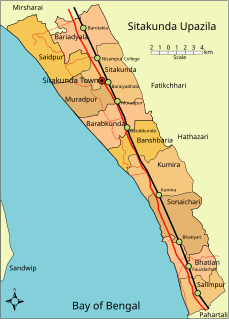
Sitakunda is an upazila, or administrative unit, in the Chittagong District of Bangladesh. It includes one urban settlement, the Sitakunda Town, and 10 unions, the lowest of administrative units in Bangladesh. It is one of the 14 upazilas, the second tier of administrative units, of the Chittagong District, which also includes 12 thanas, the urban equivalent of upazilas. The district is part of the Chittagong Division, the highest order of administrative units in Bangladesh. Sitakunda is the home of the country's first eco-park, as well as alternative energy projects, specifically wind energy and geothermal power.

Hakim Habibur Rahman
(23 March 1881 – 23 February 1947) was an Unani physician, litterateur, journalist, politician and chronicler in early 20th-century Dhaka, British India.

The Armenian community of Dhaka played a significant role in Bengali trade and commerce in the 17th and 18th centuries. A neighborhood in Dhaka - Armanitola - bears their name; the Armenian Church of the Holy Resurrection and cemetery established by the community in 1781 are major landmarks. The records of Church of the Holy Resurrection list over 200 deaths between 1833-1918, over 250 baptisms and over 50 marriages. Their assertive presence, however, began to decline from the beginning of British rule. Michael Joseph Martin is reported to have been the last Armenian in Dhaka.
The Singranatore family is the consanguineous name given to a noble family in Rajshahi of landed aristocracy in erstwhile East Bengal that were prominent in the nineteenth century till the fall of the monarchy in India by Royal Assent in 1947 and subsequently abolished by the newly formed democratic Government of East Pakistan in 1950 by the State Acquisition Act.
The Muslim Students Federation (MSF) was founded on 1 September 1937 under the presidency of Mr. Shafi in Islamia College. Allama Iqbal was elected as Patron in chief, =Hameed Nizami as President and Doctor Abdul Islam Khurshid as General Sectary. First donation for Muslim Student Federation was 100 rupees given by Nawab Sir Shah Nawaz of Mumdot. First constitution for Muslim Student Federation was made by Dr. Allama Muhammad Iqbal. First section of Muslim Student Federation was held in Calcutta in 1937. Several students leaders reached their glory and became the part of governments. After the partition msf was organised under patronage of Quaid-e-millath Ismail Sahib and K.M Seethi Sahib.After the independence MSF became the students wing of Indian Union Muslim league in India. Also MSF became the students wing of Pakistan Muslim League.Now Muslim Students Federation-MSF the National President T.P Asharaf Ali, the National General Secretary S.H. Muhammed Arshad
The Pagal Panthis were a socio-religious order that emerged in the late 18th century CE in the Mymensingh region of Bengal. Adherents of a syncretic mixture of Hinduism, Sufism and Animism, the order sought to uphold religious principles and the rights of landless peasants in Bengal; under the leadership of Tipu Shah, the movement soon evolved into a popular, armed struggle against British Raj and the zamindar (landlord) system. It was crushed with the help of the army in 1833.
Bargis were a group of Maratha soldiers who indulged in large scale plundering of the countryside of western part of Bengal for about ten years (1741–1751) during the Maratha expeditions in Bengal. Maratha invasions took place almost as an annual event for 10 years.
Kalindi River is a tidal estuarine river in and around the Sundarbans in North 24 Parganas district in the Indian state of West Bengal, bordering on Satkhira District of Bangladesh.

The East Bengal State Acquisition and Tenancy Act of 1950 was a law passed by the newly formed democratic Government of East Bengal in the Dominion of Pakistan. The bill was drafted on 31 March 1948 during the early years of Pakistan and passed on 16 May 1951. Before passage of the legislature, landed revenue laws of Bengal consisted of the Permanent Settlement Regulations of 1793 and the Bengal Tenancy Act of 1885.
Kazipur River flows through Kazipur Upazila in Sirajganj District, Bangladesh. It then flows south and joins the Ichamati River.

The Assam Bengal Railway (ABR) was one of the pioneering railway companies in British India. Headquartered in Chittagong, it functioned from 1892 to 1942.
Pabna Peasant Uprising (1873–76) was a resistance movement by the peasants ("Ryots") against the lords of the lands in Bengal ("zamindars") in the Yusufshahi pargana in Pabna.It was led by Ishan Chandra Roy.
The Bengal Tenancy Act 1885 was an enactment of the Bengal government that defined the rights of zamindars (lords) and their tenants in response to a widespread peasant revolt.

The national symbols of the Bangladesh consist of symbols to represent Bangladeshi traditions and ideals that reflect the different aspects of the cultural life and history. Bangladesh has several official national symbols including a historic document, a flag, an emblem, an anthem, memorial towers as well as several national heroes. There are also several other symbols including the national animal, bird, flower and tree.

